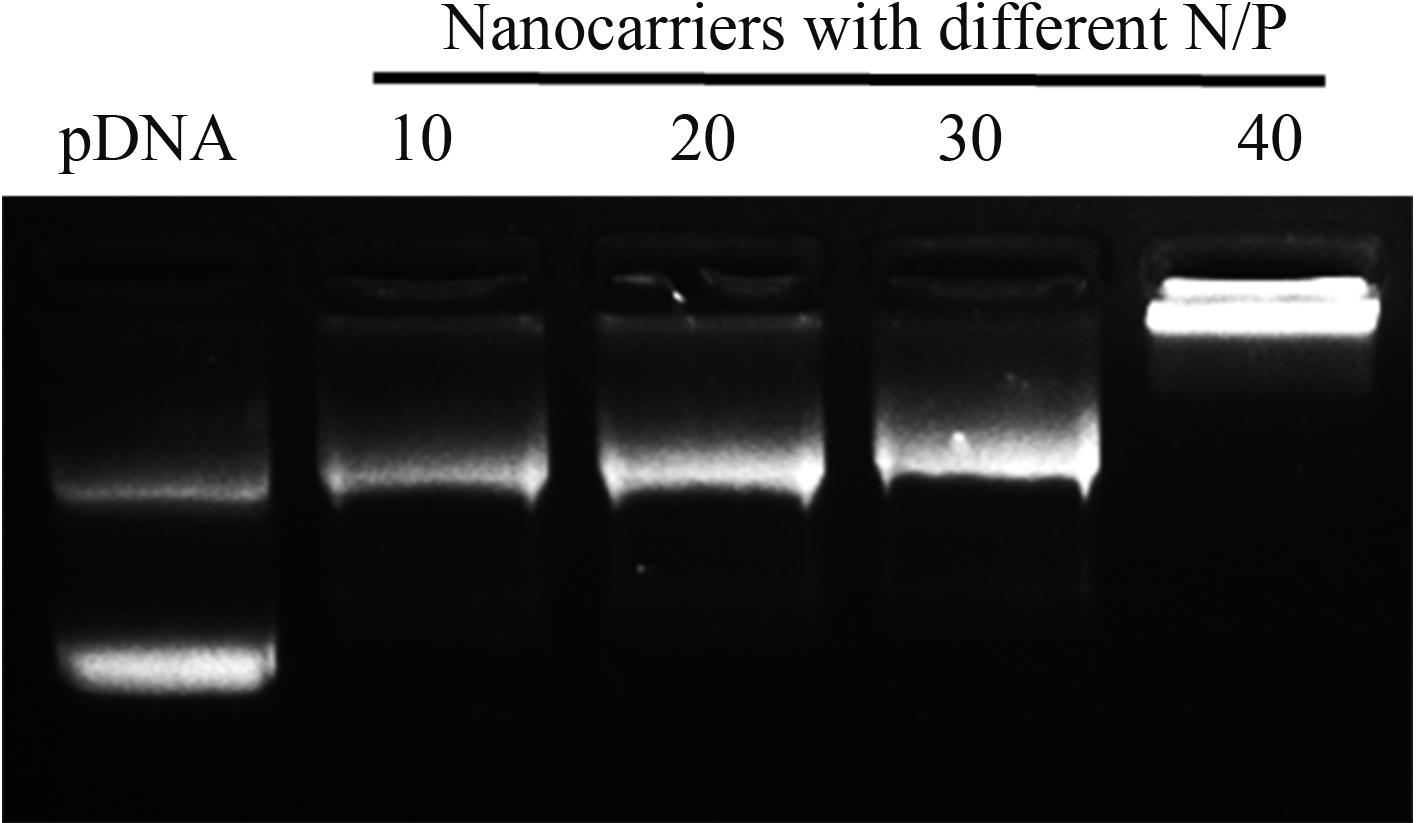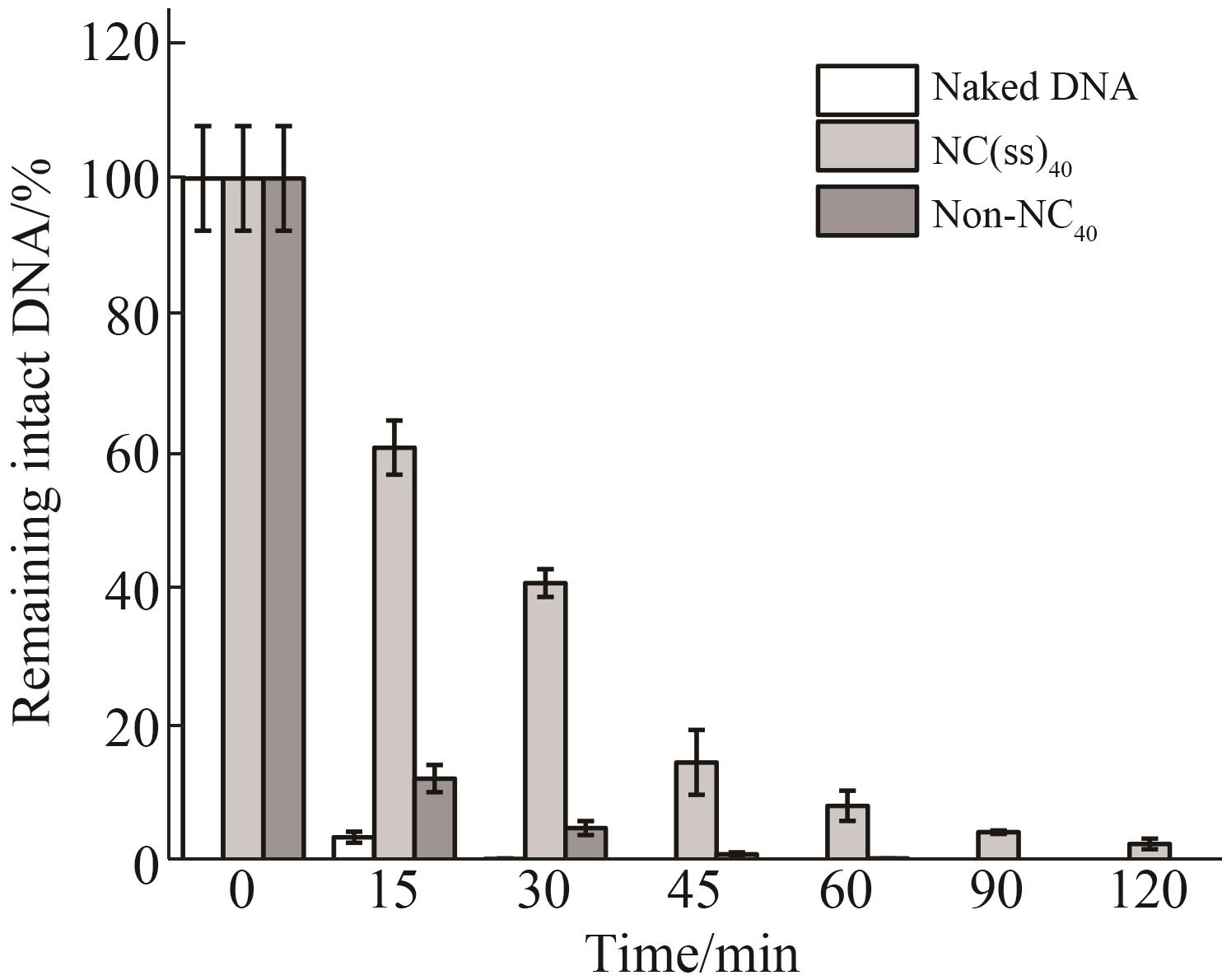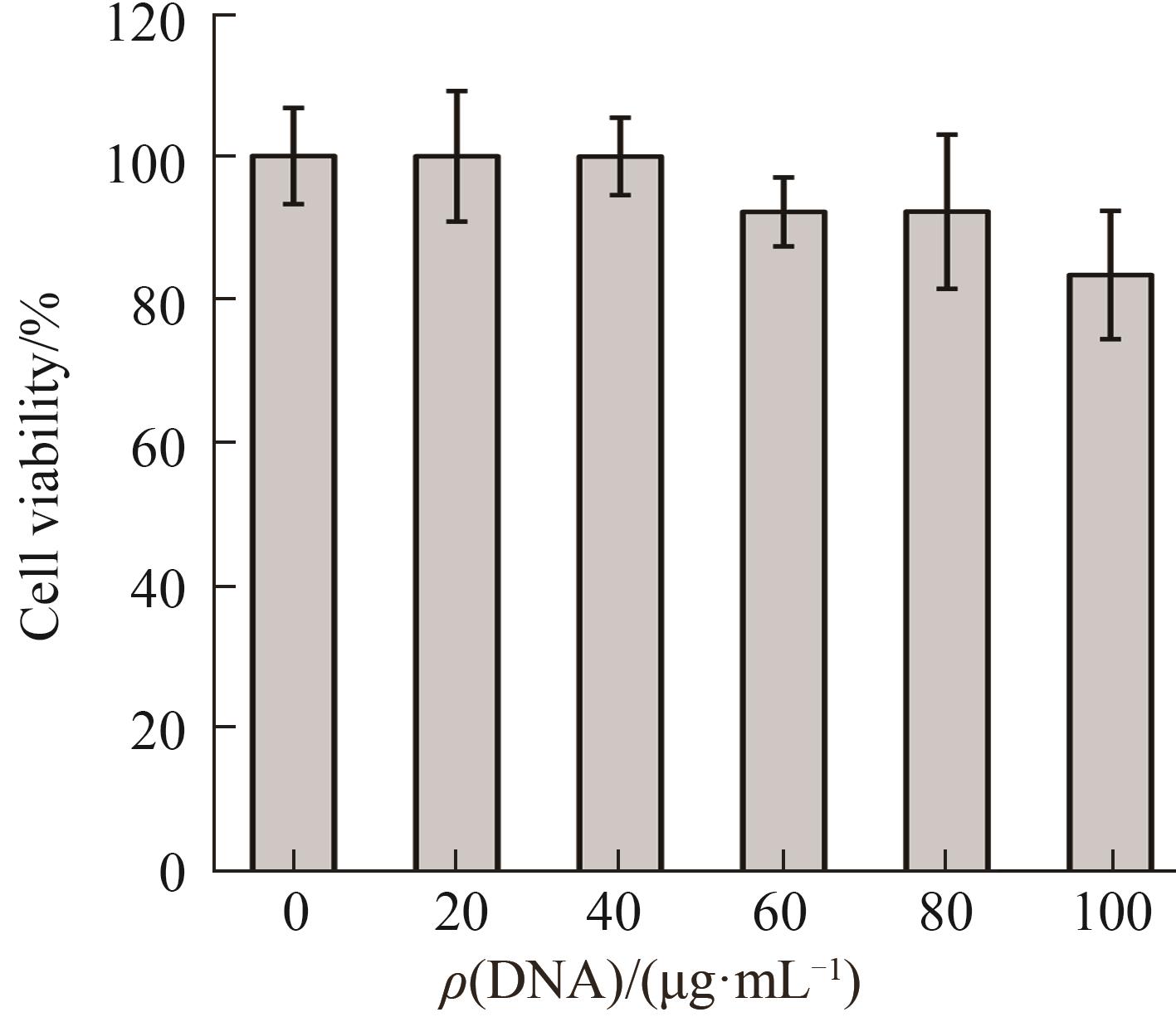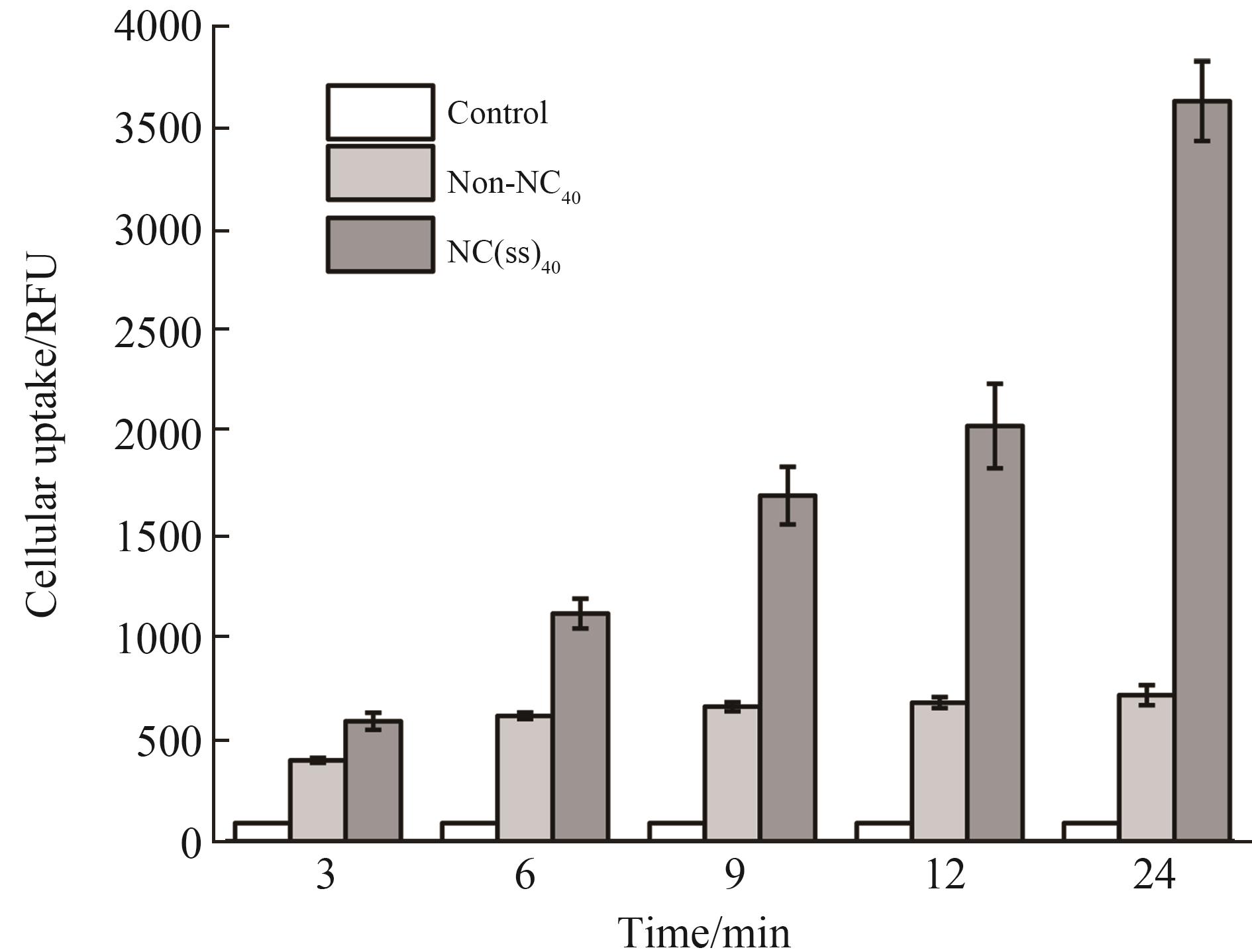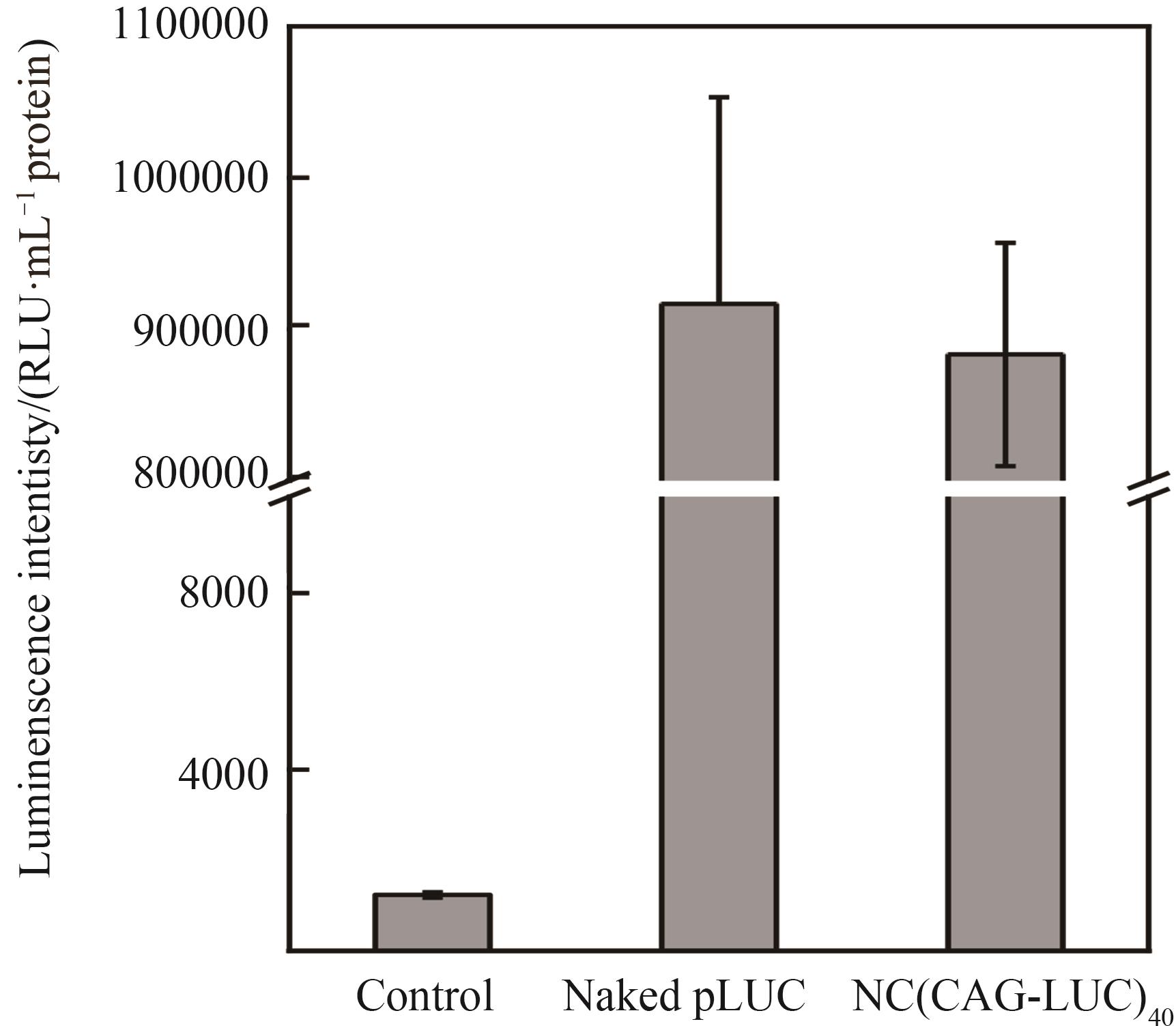
应用化学 ›› 2022, Vol. 39 ›› Issue (10): 1510-1522.DOI: 10.19894/j.issn.1000-0518.220080
基于原位聚合技术构建细胞内微环境响应型DNA递送系统
焦元昊, 崔洪燕, 张留伟, 曾爽, 王浩, 张明, 王静云( ), 陈麒先(
), 陈麒先( )
)
- 大连理工大学生物工程学院,大连 116024
-
收稿日期:2022-03-17接受日期:2022-07-03出版日期:2022-10-01发布日期:2022-10-05 -
通讯作者:王静云,陈麒先 -
基金资助:国家自然科学基金(21878041);中央高校基本科研业务费专项资金(Nos.DUT17RC(3)059, DUT20YG126)和大连市科技创新基金(2020JJ26SN050)
Fabrication of Multifunctional Gene Delivery Systems Responsible to Intracellular Microenvironments Through in situ Polymerization
Yuan-Hao JIAO, Hong-Yan CUI, Liu-Wei ZHANG, Shuang ZENG, Hao WANG, Ming ZHANG, Jing-Yun WANG( ), Qi-Xian CHEN(
), Qi-Xian CHEN( )
)
- School of Bioengineering,Dalian University of Technology,Dalian 116024,China
-
Received:2022-03-17Accepted:2022-07-03Published:2022-10-01Online:2022-10-05 -
Contact:Jing-Yun WANG,Qi-Xian CHEN -
About author:wangjingyun67@dlut.edu.cn
qixian@dlut.edu.cn;
-
Supported by:the National Natural Science Foundation of China(21878041);the Fundamental Research Funds for the Central Universities (Nos.DUT17RC(3)059, DUT20YG126),and the Dalian Science and Technology Innovation Foundation Funding(2020JJ26SN050)
摘要:
传统的非病毒载体基于分子间静电自组装作用与核酸结合,组装的复合物在体内复杂的环境中容易发生结构解离,共价结合的交联聚合物载体有望成为解决传统非病毒载体结构稳定性差的有效方案。选择N- (3-氨丙基)甲基丙烯酰胺盐酸盐、1-乙烯基咪唑、2-甲基丙烯酰氧乙基磷酸胆碱与N,N′-双(丙稀酰)胱胺作为多功能性单体,采用原位聚合方法制备包载质粒DNA (pDNA) 的交联聚合物-pDNA复合物。其中,共价键为载体提供优异的结构稳定性; 1-乙烯基咪唑能够响应胞内溶酶体酸性微环境,触发质子海绵效应便于复合物的溶酶体逃逸;N,N′-双(丙稀酰)胱胺的二硫键可以响应胞内高水平的谷胱甘肽 (GSH),实现复合物在细胞内部选择性解聚,释放内含pDNA。研究表明,该复合物平均水合半径约135 nm,ζ电势约-6.5 mV,形貌近似球形。该复合物可在10 mg/mL肝素环境中保持结构稳定性,具有响应细胞内GSH,触发释放包载核酸分子的功能。细胞实验证明该复合物细胞毒性低。细胞摄取、转染能力强。综上所述,基于原位聚合技术制备交联聚合物载体在基因递送领域具有重要应用前景,本研究为新型基因递送载体的开发提供了新思路。
中图分类号:
引用本文
焦元昊, 崔洪燕, 张留伟, 曾爽, 王浩, 张明, 王静云, 陈麒先. 基于原位聚合技术构建细胞内微环境响应型DNA递送系统[J]. 应用化学, 2022, 39(10): 1510-1522.
Yuan-Hao JIAO, Hong-Yan CUI, Liu-Wei ZHANG, Shuang ZENG, Hao WANG, Ming ZHANG, Jing-Yun WANG, Qi-Xian CHEN. Fabrication of Multifunctional Gene Delivery Systems Responsible to Intracellular Microenvironments Through in situ Polymerization[J]. Chinese Journal of Applied Chemistry, 2022, 39(10): 1510-1522.
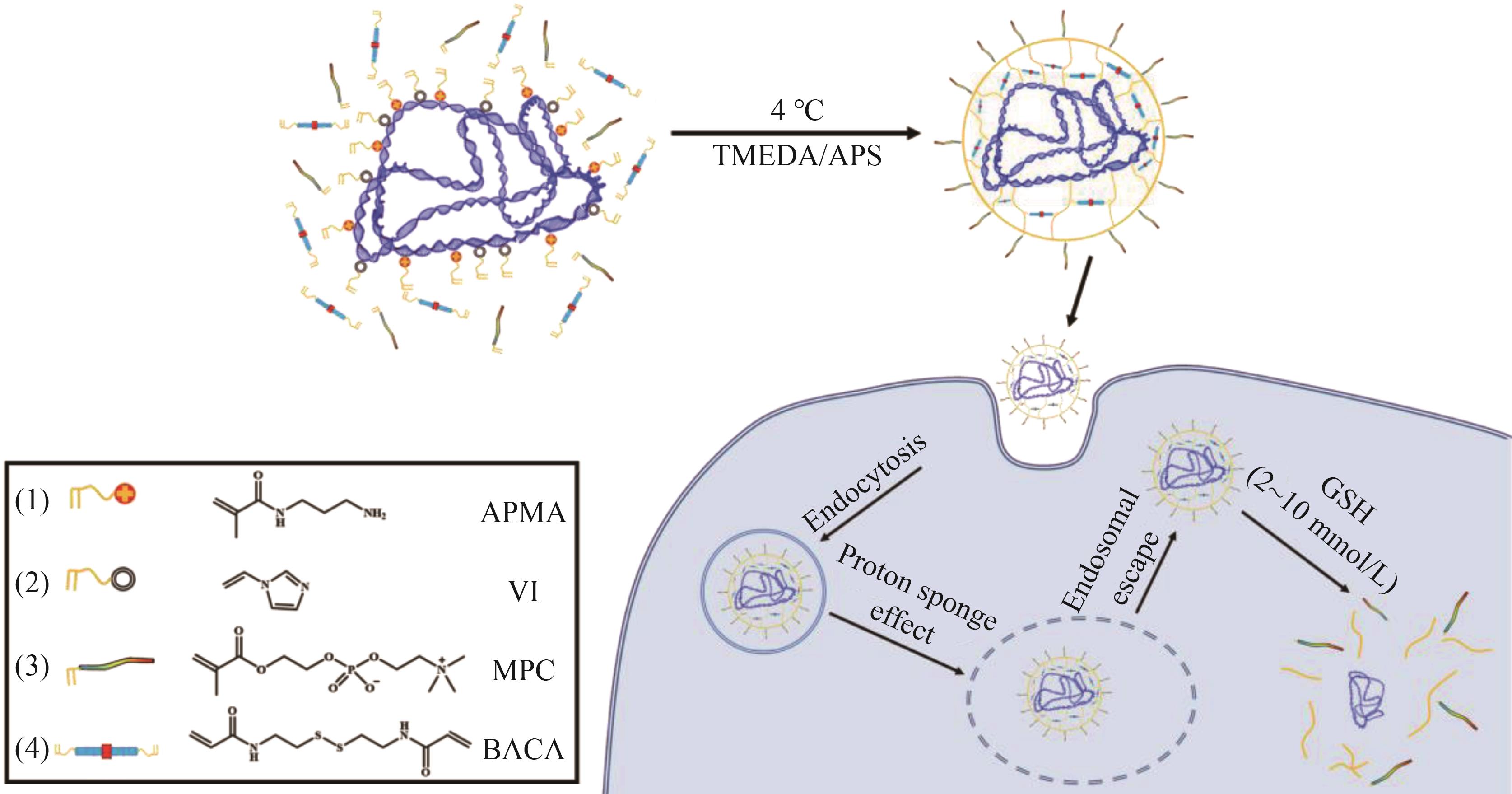
图1 载体-pDNA复合物的合成以及细胞内微环境响应释放pDNA的示意图
Fig.1 Schematic illustration of fabrication of the vector-pDNA complex and the release of pDNA in response to sequential biological microenvironments
N?(3?氨丙基)甲基丙烯酰胺盐酸盐 APMA | 1?乙烯基咪唑 VI | 2?甲基丙烯酰氧乙基磷酸胆碱 MPC | 交联剂 Crosslinker | 质粒 Plasmid | |
|---|---|---|---|---|---|
| non?NC40 | + | + | + | ? | RFP |
| NC(ss)40 | + | + | + | BACA(+) | RFP |
| NC(cc)40 | + | + | + | MBA(+) | RFP |
| NC(MPC+)40 | + | + | + | BACA(+) | ? |
| NC(MPC-)40 | + | + | ? | BACA(+) | ? |
| NC(CAG?LUC)40 | + | + | + | BACA(+) | CAG?LUC |
表1 不同NC的单体组成
Table 1 Monomer compositions of a number of NCs
N?(3?氨丙基)甲基丙烯酰胺盐酸盐 APMA | 1?乙烯基咪唑 VI | 2?甲基丙烯酰氧乙基磷酸胆碱 MPC | 交联剂 Crosslinker | 质粒 Plasmid | |
|---|---|---|---|---|---|
| non?NC40 | + | + | + | ? | RFP |
| NC(ss)40 | + | + | + | BACA(+) | RFP |
| NC(cc)40 | + | + | + | MBA(+) | RFP |
| NC(MPC+)40 | + | + | + | BACA(+) | ? |
| NC(MPC-)40 | + | + | ? | BACA(+) | ? |
| NC(CAG?LUC)40 | + | + | + | BACA(+) | CAG?LUC |
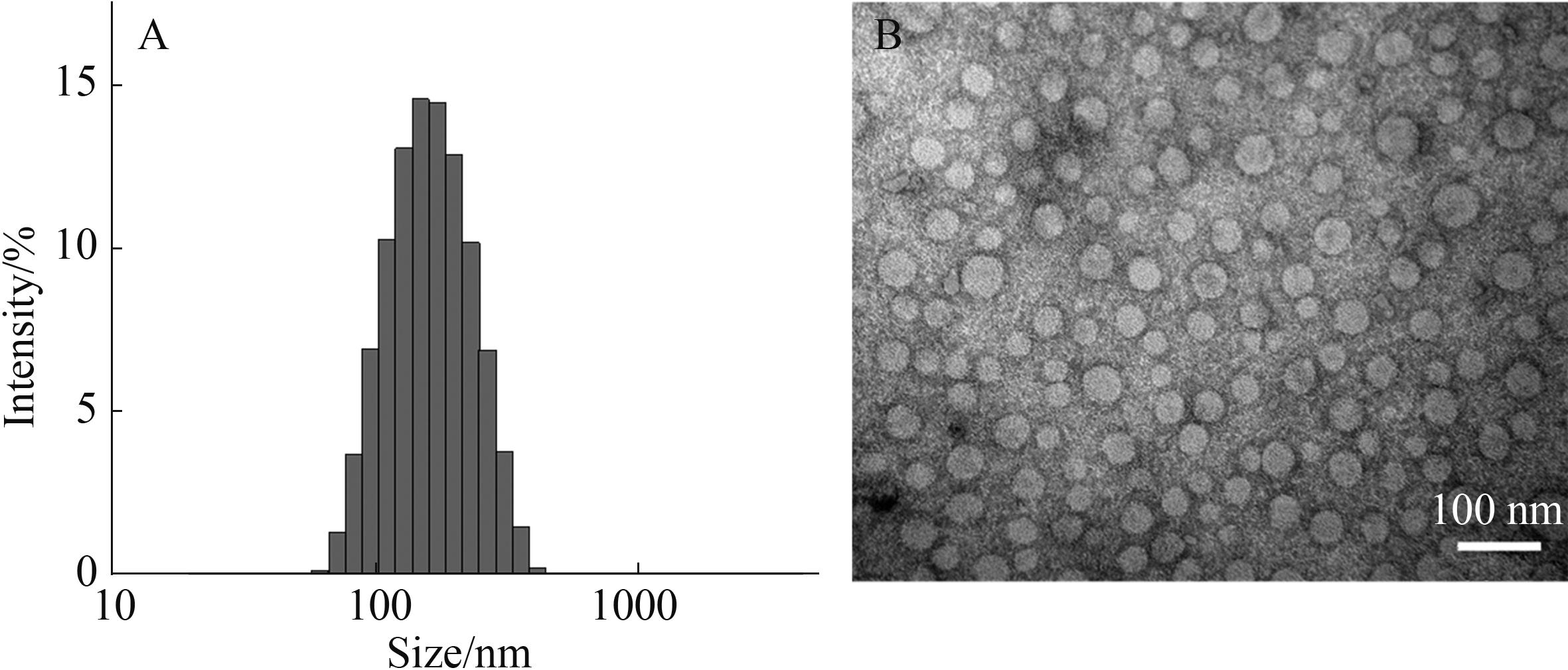
图3 NC(ss)40粒径分析。 (A)NC(ss)40的DLS流体动力学半径;(B)NC(ss)40的TEM微观形貌
Fig.3 Particle size analysis of NC(ss)40. (A) Hydrodynamic radius of NC(ss)40 by DLS measurement; (B) Microscopic morphologies of NC(ss)40 by TEM measurement

图4 肝素处理后NC(PEI)(A)、 non-NC40 (B)和NC(ss)40 (C)的凝胶电泳分析
Fig.4 Agarose gel electrophoresis for insight into the structural stabilities of NC(PEI)(A), non-NC40 (B) and NC(ss)40 (C)
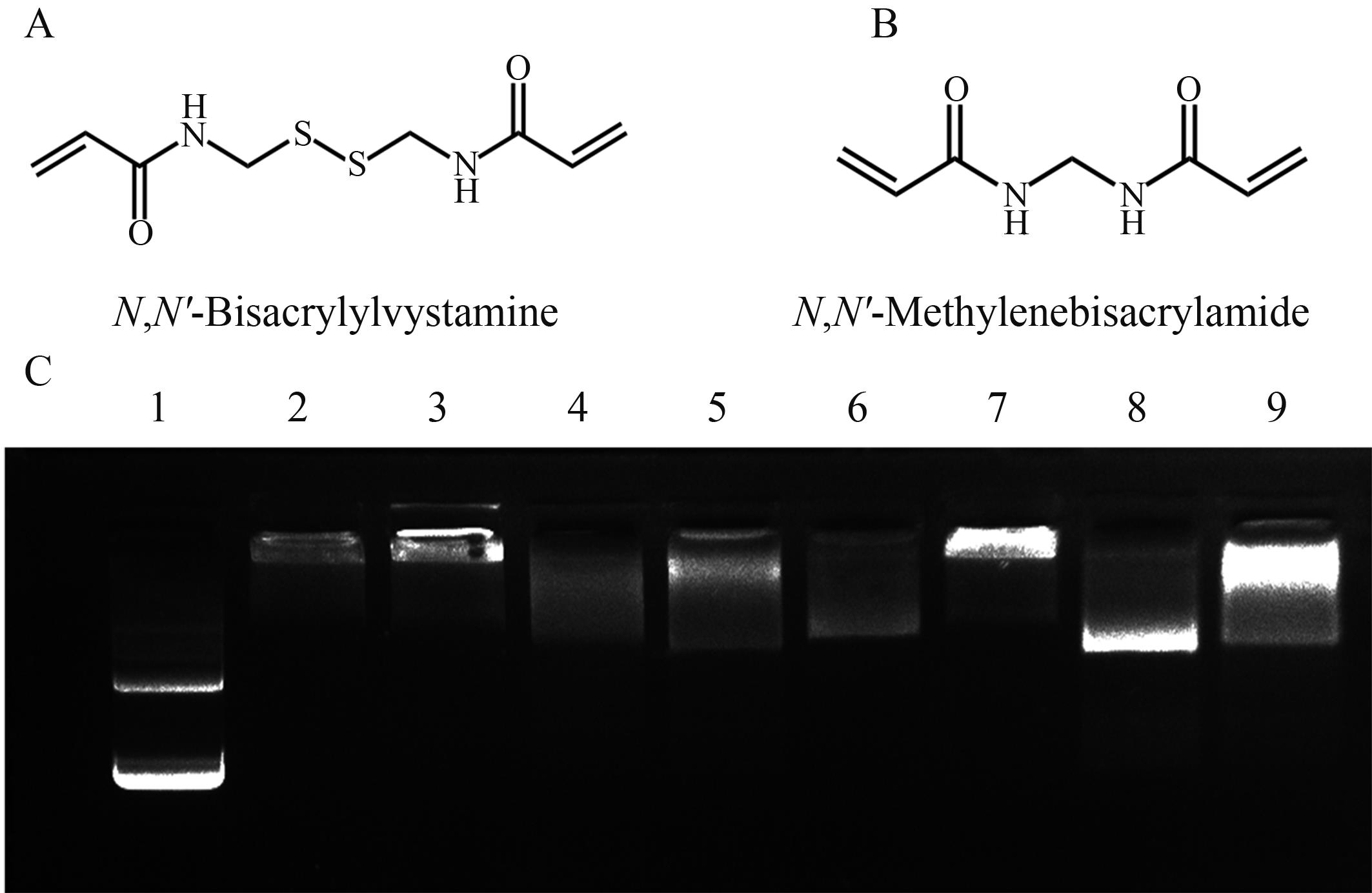
图5 (A) N,N′-双(丙稀酰)胱胺与 (B) N,N′-亚甲基双丙烯酰的化学结构式。(C) 两种负载 pDNA 的复合物经过各种DTT和肝素处理后的凝胶电泳分析
Fig.5 Chemical structures of (A) N,N′-bis(acryloyl)cystamine and (B) N,N′-methylenebisacryloyl. (C) Electropherograms of two pDNA-loaded complexes after various DTT and heparin treatments
泳道 Line | 质粒/复合物 pDNA/NC | 二硫苏糖醇 DTT | 肝素 Heparin |
|---|---|---|---|
| 1 | pDNA | ? | ? |
| 2 | NC(ss)40 | ? | ? |
| 3 | NC(cc)40 | ? | ? |
| 4 | NC(ss)40 | ? | + |
| 5 | NC(cc)40 | ? | + |
| 6 | NC(ss)40 | + | ? |
| 7 | NC(cc)40 | + | ? |
| 8 | NC(ss)40 | + | + |
| 9 | NC(cc)40 | + | + |
表2 图5中各泳道样品及反应条件
Table 2 Samples and reaction conditions in each lane in Fig.5
泳道 Line | 质粒/复合物 pDNA/NC | 二硫苏糖醇 DTT | 肝素 Heparin |
|---|---|---|---|
| 1 | pDNA | ? | ? |
| 2 | NC(ss)40 | ? | ? |
| 3 | NC(cc)40 | ? | ? |
| 4 | NC(ss)40 | ? | + |
| 5 | NC(cc)40 | ? | + |
| 6 | NC(ss)40 | + | ? |
| 7 | NC(cc)40 | + | ? |
| 8 | NC(ss)40 | + | + |
| 9 | NC(cc)40 | + | + |

图7 不同浓度NC(MPC+)40和NC(MPC-)40红细胞溶血率注:“**”表示单因素方差分析P<0.01, “***”表示单因素方差分析P<0.001
Fig.7 Erythrocyte hemolysis rate of red blood cells upon incubation in presence of varied concentrated NC(MPC+)40 and NC(MPC-)40Note: “**” indicates P<0.01 in one-way ANOVA, “***” indicates P<0.001 in one-way ANOVA
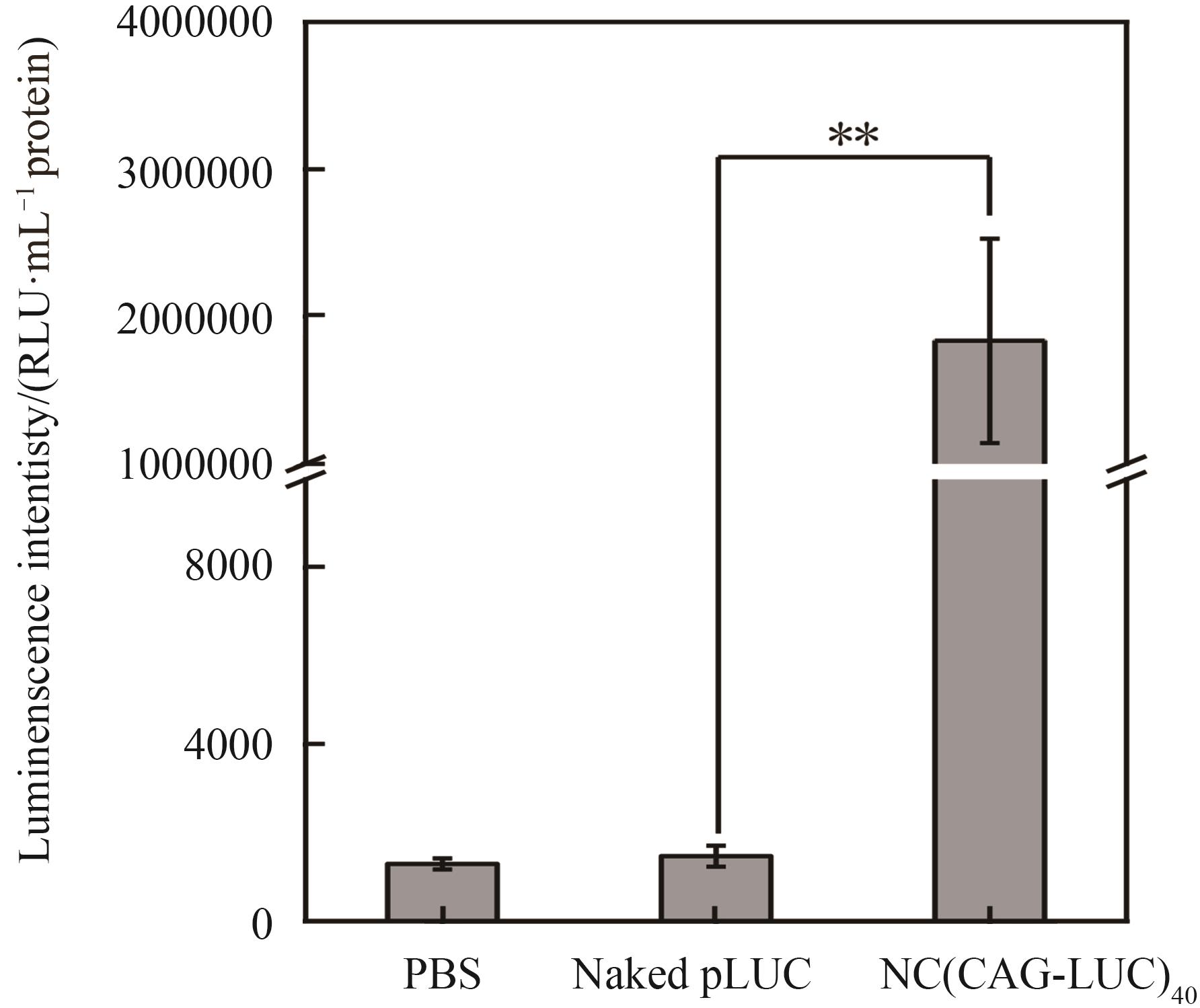
图11 NC(CAG-LUC)40在MCF-7细胞中表达荧光素酶分析注:“**”表示单因素方差分析P<0.01
Fig.11 Quantification of gene expression of NC(CAG-LUC)40 in MCF-7 cellsNote: “**” indicates P<0.01 in one-way ANOVA
| 1 | 韩旭, 丁冠宇, 董青, 等. 基于脂质体的纳米基因载体的研究进展[J]. 应用化学, 2018, 35(7): 735-744. |
| HAN X, DING G Y, DONG Q, et al. Research progress of nano-gene carriers based on liposomes[J]. Chinese J Appl Chem, 2018, 35(7): 735-744. | |
| 2 | HIRKO A, TANG F, HUGHES J A. Cationic lipid vectors for plasmid DNA delivery[J]. Curr Med Chem, 2003, 10(14): 1185-1193. |
| 3 | 全球基因与细胞治疗相关临床试验统计[J]. 中国科技信息, 2021(12): 6-7. |
| Global gene and cell therapy related clinical trial statistics[J]. China Sci Technol Inf, 2021(12): 6-7. | |
| 4 | CICALESE M P, FERRUA F, CASTAGNARO L, et al. Update on the safety and efficacy of retroviral gene therapy for immunodeficiency due to adenosine deaminase deficiency[J]. Blood, 2016, 128(1): 45-54. |
| 5 | MARKTEL S, SCARAMUZZA S, CICALESE M P, et al. Intrabone hematopoietic stem cell gene therapy for adult and pediatric patients affected by transfusion-dependent β-thalassemia[J]. Nat Med, 2019, 25(2): 234-241. |
| 6 | THOMPSON A A, WALTERS M C, KWIATKOWSKI J, et al. Gene therapy in patients with transfusion-dependent β-thalassemia[J]. N Engl J Med, 2018, 378(16): 1479-1493. |
| 7 | MCERLEAN E M, MCCRUDDEN C M, MCCARTHY H O. Delivery of nucleic acids for cancer gene therapy: overcoming extra-and intra-cellular barriers[J]. Ther Deliv, 2016, 7(9): 619-637. |
| 8 | FARMER Z L, KIM E S, CARRIZOSA D R. Gene therapy in head and neck cancer[J]. Oral Maxil Surg, 2019, 31(1): 117-124. |
| 9 | MORILLE M, PASSIRANI C, VONARBOURG A, et al. Progress in developing cationic vectors for non-viral systemic gene therapy against cancer[J]. Biomaterials, 2008, 29(24-25): 3477-3496. |
| 10 | TEMPLETON N S. Cationic liposome-mediated gene delivery in vivo[J]. Biosci Rep, 2002, 22(2): 283-295. |
| 11 | LIN G, LI L, PANWAR N, et al. Non-viral gene therapy using multifunctional nanoparticles: status, challenges, and opportunities[J]. Coordin Chem Rev, 2018, 374: 133-152. |
| 12 | 王嫱, 张琳, 陈赛娟. 基因治疗: 现状与展望[J]. 中国基础科学, 2017, 19(4): 21-27. |
| WANG C, ZHANG L, CHEN S J. Gene therapy: current situation and prospect[J]. China Basic Sci, 2017, 19(4): 21-27. | |
| 13 | WILSON J M. Lessons learned from the gene therapy trial for ornithine transcarbamylase deficiency[J]. Mol Genet Metab, 2009, 96(4): 151-157. |
| 14 | ILARDUYA C, YAN S, NEJAT DÜZGÜNE. Gene delivery by lipoplexes and polyplexes[J]. Eur J Pharm Sci, 2010, 40(3): 159-170. |
| 15 | GU Z, YAN M, HU B, et al. Protein nanocapsule weaved with enzymatically degradable polymeric network[J]. Nano Lett, 2009, 9(12): 4533-4538. |
| 16 | 姜中雨, 刘仪轩, 冯祥汝, 等. 功能性聚氨基酸纳米凝胶[J]. 功能高分子学报, 2019, 32(1): 13-27. |
| JIANG Z Y, LIU Y X, FENG X R, et al. Functional polypeptide nanogels[J]. J Funct Polym, 2019, 32(1): 13-27. | |
| 17 | LIU Y, GOEBL J, YIN Y. Templated synthesis of nanostructured materials[J]. Chem Soc Rev, 2013, 42(7): 2610-2653. |
| 18 | WU Y, NG D Y W, KUAN S L, et al. Protein-polymer therapeutics: a macromolecular perspective[J]. Biomater Sci, 2015, 3(2): 214-230. |
| 19 | PELEGRI-O′DAY E M, LIN E W, MAYNARD H D. Therapeutic protein-polymer conjugates: advancing beyond PEGylation[J]. J Am Chem Soc, 2014, 136(41): 14323-14332. |
| 20 | VITTORIO O, COJOC M, CURCIO M, et al. Polyphenol conjugates by immobilized laccase: the green synthesis of dextran-catechin[J]. Chem Phys, 2016, 217(13): 1488-1492. |
| 21 | CHEN G, ABDEEN A A, WANG Y, et al. A biodegradable nanocapsule delivers a Cas9 ribonucleoprotein complex for in vivo genome editing[J]. Nanotechnol, 2019, 14(10): 974-980. |
| 22 | LIU C, WEN J, MENG Y, et al. Efficient delivery of therapeutic miRNA nanocapsules for tumor suppression[J]. Adv Mater, 2015, 27(2): 292-297. |
| 23 | 韩旭, 张留伟, 张强, 等. 活性氧响应的新型阳离子共聚物构建及其基因递送性能研究[J].化学学报,2021, 79(6): 9. |
| HAN X, ZHANG L W, ZHANG Q, et al. Construction of a novel reactive oxygen species-responsive cationic copolymer and its performance in gene delivery[J]. Acta Chim Sin, 2021, 79(6): 9. |
| [1] | 夏颖, 夏菁, 崔洪燕, 钱明, 张留伟, 陈麒先, 王静云. 同源细胞膜包覆智能释药纳米粒用于肝癌靶向治疗[J]. 应用化学, 2020, 37(1): 69-79. |
| [2] | 唐成,邹志娟,宋昆鹏. Ni-P共掺杂超交联聚合物的制备及催化还原4-硝基苯酚[J]. 应用化学, 2019, 36(7): 782-789. |
| [3] | 陈广美,汪志坤,吴立霞,黄毅萍. 丙烯酸酯改性水性聚氨酯/纳米二氧化硅复合材料的制备和性能[J]. 应用化学, 2019, 36(5): 532-538. |
| [4] | 孙婷婷, 李文亮, 谢志刚, 景遐斌. 基于交联聚合物的新型非均相光催化剂的制备与应用[J]. 应用化学, 2014, 31(05): 548-552. |
| [5] | 郭建, 章于川, 吴兵. 原位聚合法制备纳米二氧化硅/聚氨酯复合树脂[J]. 应用化学, 2011, 28(11): 1244-1249. |
| [6] | 李伟, 路福绥, 翟利利, 王祜英, 郭雯婷. 不同相对分子质量羟乙基纤维素对甲维盐微胶囊制备的影响[J]. 应用化学, 2011, 28(10): 1108-1113. |
| [7] | 李伟, 路福绥, 郭雯婷, 李慧. 甲胺基阿维菌素苯甲酸盐微胶囊的制备与表征[J]. 应用化学, 2010, 27(12): 1381-1385. |
| [8] | 黄雪原, 郭建平, 沈加春, 陈小花, 尹笃林. 含[BMIM]Cl-ZnCl2和非质子溶剂的凝胶聚合物电解质的合成[J]. 应用化学, 2009, 26(10): 1139-1143. |
| [9] | 赵才贤, 张平, 许福, 姜勇, 王霞瑜. 新型PA6/EP/SiO2纳米复合材料的制备[J]. 应用化学, 2008, 25(9): 1042-1046. |
| [10] | 陈晶晶, 朱传方, 秦正妮, 白一穷. 纳米SiO2含量对水性聚氨酯复合材料性能的影响[J]. 应用化学, 2008, 25(9): 1047-1051. |
| [11] | 郭建平, 黄雪原, 尹笃林. MMA在路易斯酸性离子液体[BMIM]Cl-ZnCl2中原位聚合[J]. 应用化学, 2008, 25(6): 685-688. |
| [12] | 冯莉, 刘炯天, 宋所讲. 高岭土对不饱和聚酯树脂的热稳定性、阻燃及力学性能的影响[J]. 应用化学, 2008, 25(12): 1385-1388. |
| [13] | 段洪东, 孟霞, 秦大伟, 刘温霞. 流变学法研究交联聚合物凝胶的抗剪切性能[J]. 应用化学, 2006, 23(7): 743-746. |
| [14] | 袁青梅, 杨红卫, 张发广, 王兴, 郑保忠. 原位聚合法制备鱼藤酮微胶囊[J]. 应用化学, 2006, 23(4): 382-385. |
| [15] | 徐溢, 张晓凤, 张剑, 徐平洲. 原位聚合阴离子交换型固相萃取(SPE)微柱[J]. 应用化学, 2006, 23(2): 144-148. |
| 阅读次数 | ||||||
|
全文 |
|
|||||
|
摘要 |
|
|||||
